All You Need to Know About Meshtastic
What Is Meshtastic?
Meshtastic is an open-source project that leverages LoRa, a long-range radio protocol that is widely available in most regions and does not require additional licenses or certifications, unlike HAM radio. Utilizing inexpensive LoRa radios, Meshtastic provides a FREE, long-range, off-grid communication solution for areas without reliable or existing communication infrastructure.
In a simpler way, Meshtastic is a free and easy-to-use tool that lets you send messages without internet or mobile networks. It connects small, specialized devices to create a network where you can communicate over long distances, making it perfect for outdoor adventures, emergencies, or communication in remote areas. You can share short text messages, GPS locations, and even voice messages (coming soon) with others. It’s easy to set up, works on various devices, and has a supportive community if you need help.
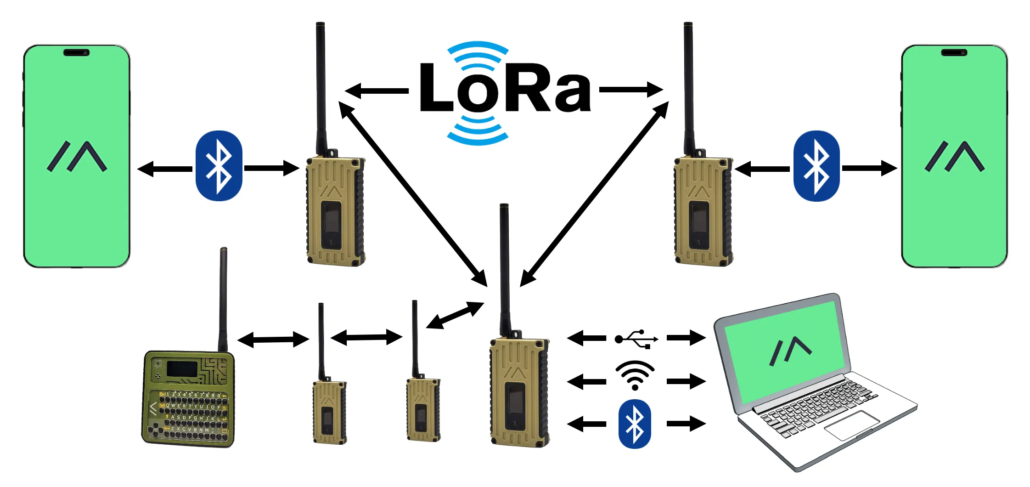
(Image credit: meshtastic.org)
What Can Meshtastic Do?
In today’s tech-focused world, it’s hard to picture a day without a steady network connection. But if you’ve ever gone hiking in a remote area and lost signal, or attended a big event where the network was too crowded to use, you know the struggle. During natural disasters like typhoons or floods, communication networks might fail, making it tough to call for help or connect with loved ones. I hope you don’t face these challenges, but it’s worth thinking about potential solutions if you do. What would you want to have in place?
This is where Meshtastic comes into play, offering a potential Plan A for those rare yet crucial instances: an emergency response solution.
Why Meshtastic?
There are also many other options, such as the more well-known LoRa-based solutions like LoRaWAN® and Sidewalk, or the commonly used 4G/5G, and even Starlink developed by SpaceX. So, why Meshtastic?
Differences Between LoRaWAN®, Sidewalk, and Meshtastic
As shown below, I have listed the biggest differences between the three. Meshtastic is decentralized and doesn’t require gateways, making it better suited for flexible, independent, peer-to-peer communication scenarios, while LoRaWAN®is ideal for large-scale, centrally managed IoT applications. Amazon Sidewalk, is designed to extend the connectivity range of smart home devices using low-power, community-based networking.

Differences Between 4G/5G and Meshtastic
Most of us rely on 4G/5G networks in our daily lives, so how does Meshtastic compare to them? The main differences are outlined below. Simply put, Meshtastic is ideal for situations where there is no cellular signal, no infrastructure, or limited power availability, such as outdoor activities, survival scenarios, or rescue operations. On the other hand, cellular network coverage is primarily concentrated in areas with high levels of human activity, such as cities and urban regions.
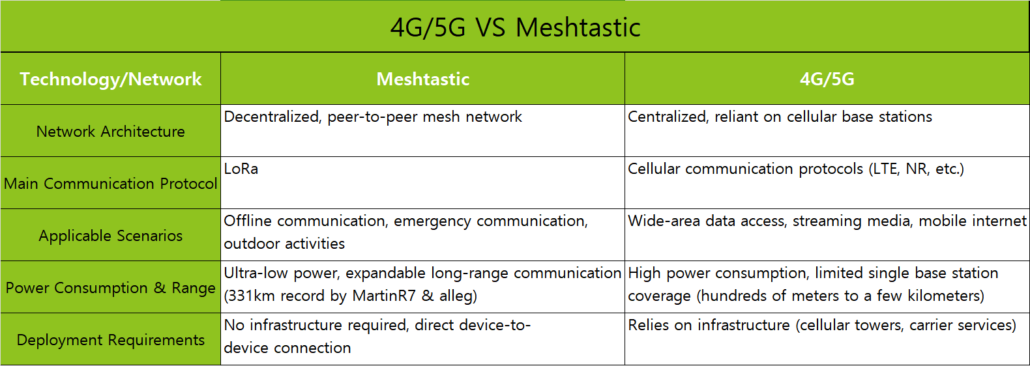
Differences Between Starlink and Meshtastic
Starlink and Meshtastic are two different communication solutions, each with its own strengths. Starlink is ideal for those who need constant online connectivity and high-speed internet access, even in remote areas. However, if you need a more affordable, portable solution for offline communication, especially when power and infrastructure are limited, Meshtastic is the better choice.
Last but not least, Meshtastic is free to use—once you purchase a compatible device, you can start enjoying the free mesh network with your friends!
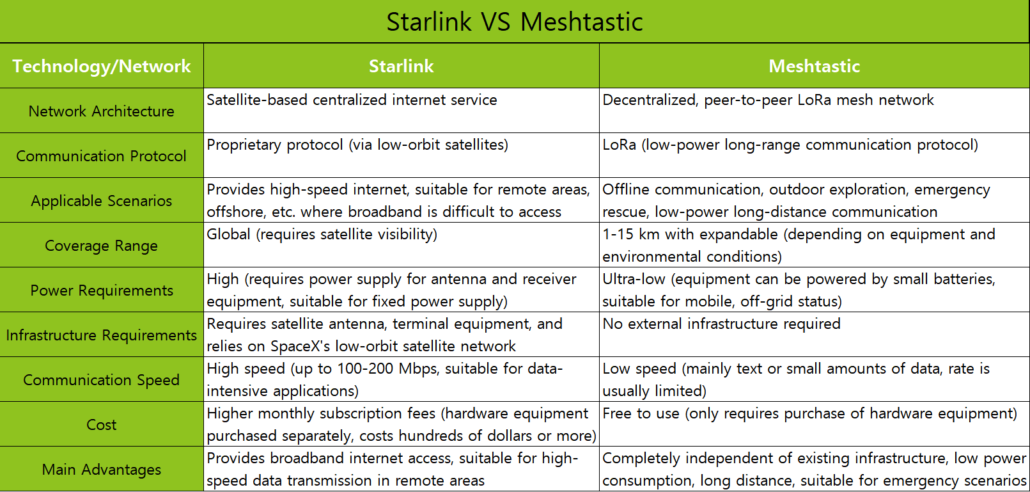
Typical Meshtastic Applications
So, what are the typical applications of Meshtatsic? Here are some common usages shared by passionate community members on Reddit about “What do you use Meshtastic for?”.
- calinet6: “Making new friends nearby who are equally nerdy by virtue of opting into this.”
- Jcw122: “‘Talking’ with friends at big festivals”
- spotcheck001: “We use it for family to communicate when we camp. Works out great.”
- Stroniu44: “Combined with ATAK to localise and communicate during exercise with other tanks from my platoon, especially exchange kmz data”
- jp_bennett: “Vehicle tracking across town, as well as emergency comms for emergency situations.”
- AnderlAnduel: “I share weather station data between home automation sytems with my neighbors (mqtt2mqtt bridge). This way we are independent of Internet services.”
What they’re sharing are exactly the applications that I suggest you to start your Meshtastic journey.
Outdoor Adventures
Whether you enjoy hiking, camping, survival skills, mountaineering, cycling, off-road driving, or skiing, it’s common to encounter areas with no 4G/5G during these outdoor activities. Using Meshtastic allows team members to stay in touch all the time during outdoor adventures, even in remote areas.

Crowded Events and Festivals
If you love big events like Burning Man, Coachella, or Midi Music Festival, you’ve probably dealt with weak signals and lost connections because of overloaded networks. With Meshtastic, you can easily and affordably create a portable, reliable, and self-controlled network infrastructure to stay connected with friends.

Search and Rescue
When disasters strike and signal or power infrastructure fails, Meshtastic can be a vital tool for emergency response, supporting search and rescue operations. A Meshtastic tracker, capable of precisely identifying the location of those in distress and maintaining communication with them, is an excellent choice for equipping rescue teams or ensuring everyday emergency preparedness.
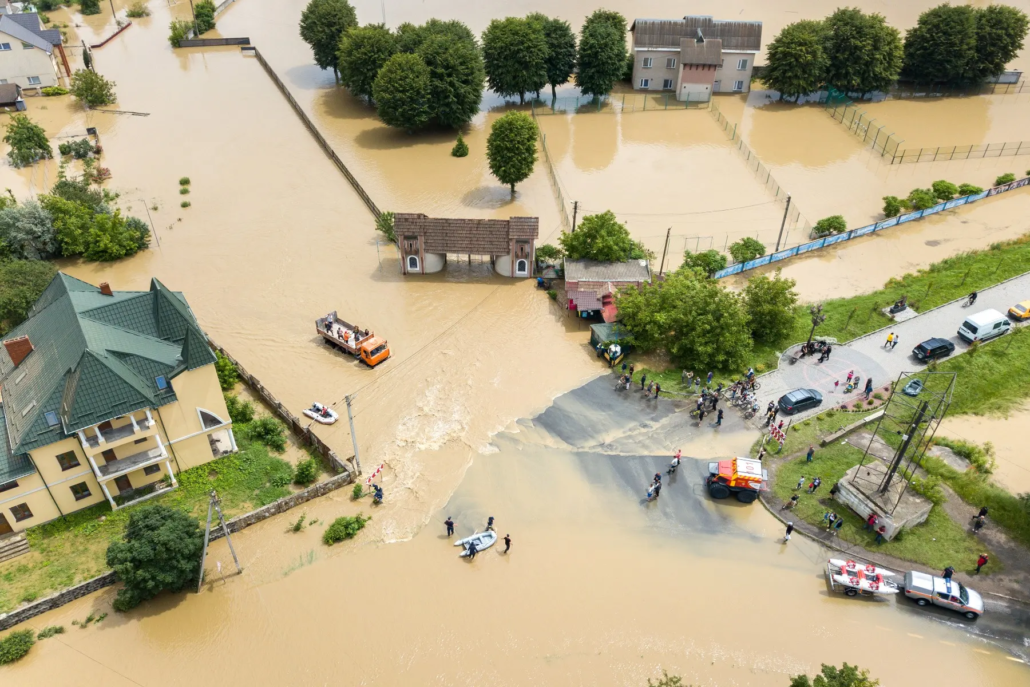
Meshtastic Limitations
Text messages only at the moment: Meshtastic uses LoRa, which focuses on long-range and low power. This limits bandwidth, so it can only send text—no images, videos, or large files.
Short messages: You can only send messages with 228 characters or fewer due to LoRa’s packet size limit, which isn’t enough for detailed or complex information.
For those new to Meshtastic, a common question is how to select the right product from the wide range of Meshtastic-compatible options, which include everything from development boards to ready-to-use devices. In the following, I will share some of the most popular Meshtastic devices with you.
Popular Meshtastic-compatible Products: A Comparison
Different products excel in different scenarios. To help you find the best fit, I’ve put together some simple recommendations based on popular products and their ideal use cases. I hope you find this helpful!
Suitable for the Beginning of Building a Mesh Network
– DIY enthusiasts, smart home, smart city
A mesh network allows for decentralized, long-range communication between devices without relying on cellular networks. For those just starting, it’s essential to select devices that are easy to use, flexible, and expandable for various applications. Here are some great starter kits that are ideal for beginners who want to build their first mesh network.
Recommended Meshtastic Devices:
1. The smallest and most affordable option for Meshtastic applications: XIAO ESP32S3 & Wio-SX262 Kit for Meshtastic $9.9
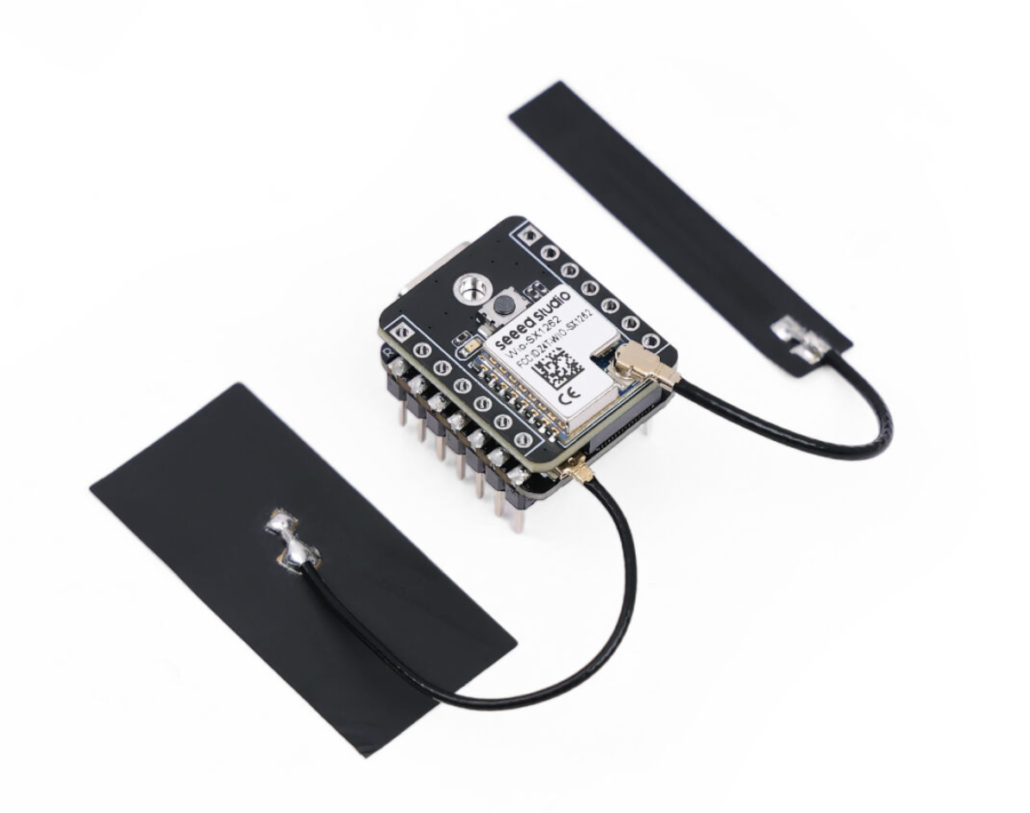
Features:
- Affordable: A budget-friendly option to kickstart your Meshtastic journey.
- Compact & Powerful: Small but mighty, with Wi-Fi and Bluetooth for IoT applications.
- Expandable: Easy to add temperature, GPS, and other Grove modules to apply to your home, garden, or any other scenarios.
Considerations:
- No enclosure: Requires some assembly and case installation before use, making it less plug-and-play than other devices.
2. The most affordable option with an onboard screen: Heltec LoRa 32 V3

Features:
- Easy to Start: Fully functioned, and well-documented, simple for beginners.
- Onboard Screen: The built-in display provides real-time feedback and interactive communication.
Considerations:
- No GPS: May not suit applications needing location tracking.
- Limited Customization: Less flexibility for adding extra sensors or modules.
- Limited Processing Power: While great for mesh networking, it may not support complex applications without additional peripherals or optimizations.
3. A versatile, solar-powered starter kit with expandable modules: RAK WisBlock Meshtastic Starter Kit
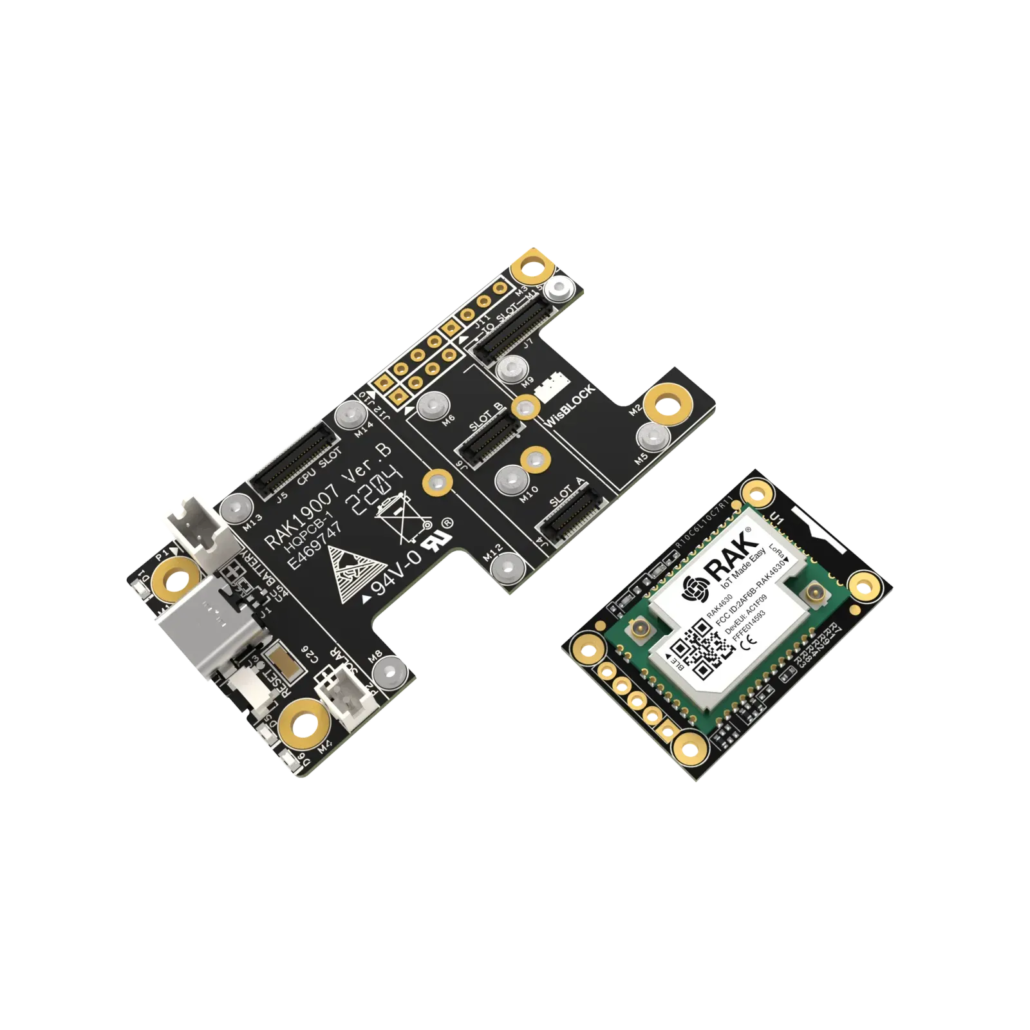
Features:
- Solar Panel Support: Ideal for outdoor use, ensuring continuous operation without frequent battery recharges.
- Highly Expandable: Can be connected to a variety of modules to monitor various environmental factors.
Considerations:
- Basic Coding Skills Required: You may need some basic coding experience to get the most out of it. However, tutorials and documentation can help guide you.
- No Enclosure Included: Requires some assembly and case installation before use.
4. A go-to device with a 18650 battery holder: T-Beam

Features:
- Easily Powered: Equipped with a 18650 battery holder, compatible with any standard rechargeable 18650 battery
- Optional OLED Combination: Pre-soldered and separated OLED for your choice.
Considerations:
- Limited Customization: Less flexibility for adding extra sensors or modules.
- No Enclosure Included: Requires some assembly and case installation before use.
Suitable for Remote Outdoor Activities
– Outdoor Activities, Remote Parties, Hiking, Backpacking, and Wilderness Exploration
When outdoor activities or exploring remote areas, staying connected and tracking your location is important for safety and coordination. However, cellular coverage is often lacking in these remote areas. The following devices are ideal for maintaining communication and location tracking over long distances without relying on cellular signals, also, having a case and small size are important.
Recommended Devices:
1. The world’s first IP65-Rated Meshtastic device: SenseCAP Card Tracker T1000-E
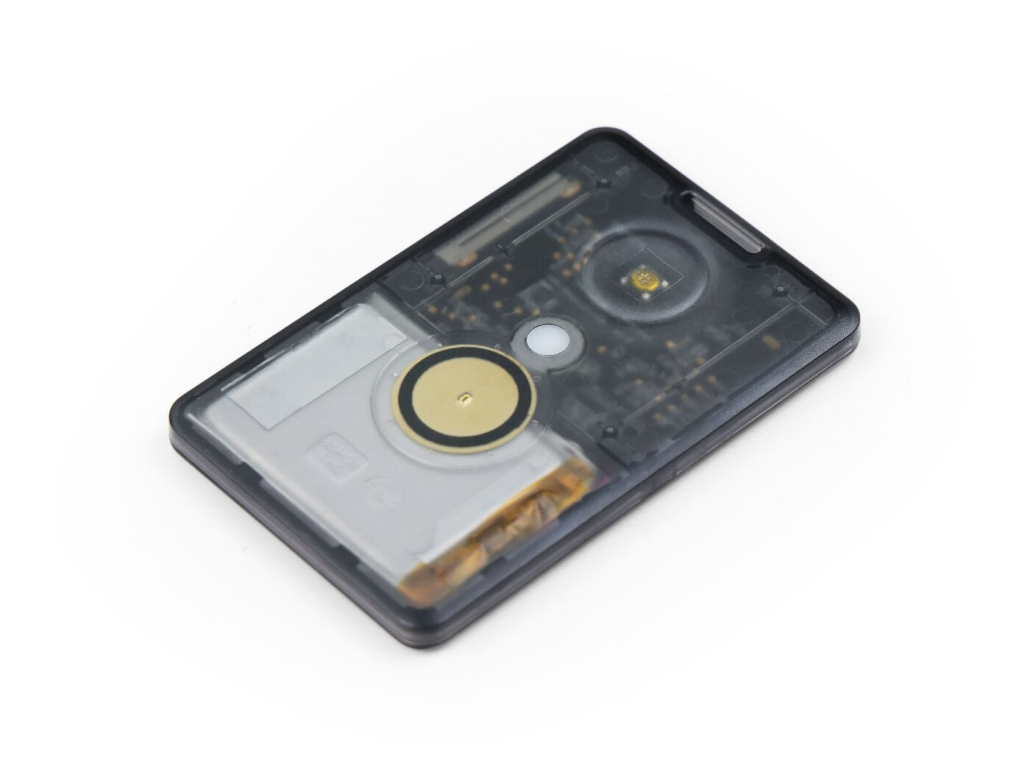
Features:
- Compact and Portable: Lightweight and easy to carry, making it perfect for long hikes and outdoor adventures.
- IP65 Waterproof Rating: Withstands rain, dust, and harsh weather conditions.
- Built-in GPS: Provides precise location tracking, essential for navigation in remote areas.
- Built-in Sensors: Built-in Temperature, Light, and 3-Axis Accelerometer.
Considerations:
- No Screen: Unable to display messages directly on the device; messages must be checked through connected devices or apps.
- Limited Scalability: Cannot be easily expanded with additional sensors or modules for customized applications.
2. A standalone device with a touchscreen, keyboard, and long battery life: T-Deck Plus

Features:
- Fully Functional Engineering Platform: Features a 2.8″ IPS touchscreen, keyboard, microphone, and speaker, offering versatile functionality similar to a mobile device.
- Long Battery Life: Powered by a 2000mAh battery, ideal for extended trips with frequent communication needs.
Considerations:
- Bulkier Design: Larger and heavier than other models, which may affect portability, particularly on long treks.
- Price side: The price is relatively higher than other products.
Suitable for Search and Emergencies
– Power outages, natural disasters, emergencies
When disaster strikes, traditional communication and power infrastructure can often collapse, leaving rescue teams and those affected without means to communicate. Whether for search and rescue operations, disaster relief coordination, or daily emergency preparedness, these devices provide an effective way to stay connected when traditional networks fail.
Recommended Devices:
1. The world’s first IP65-Rated Meshtastic device with built-in GPS: SenseCAP Card Tracker T1000-E
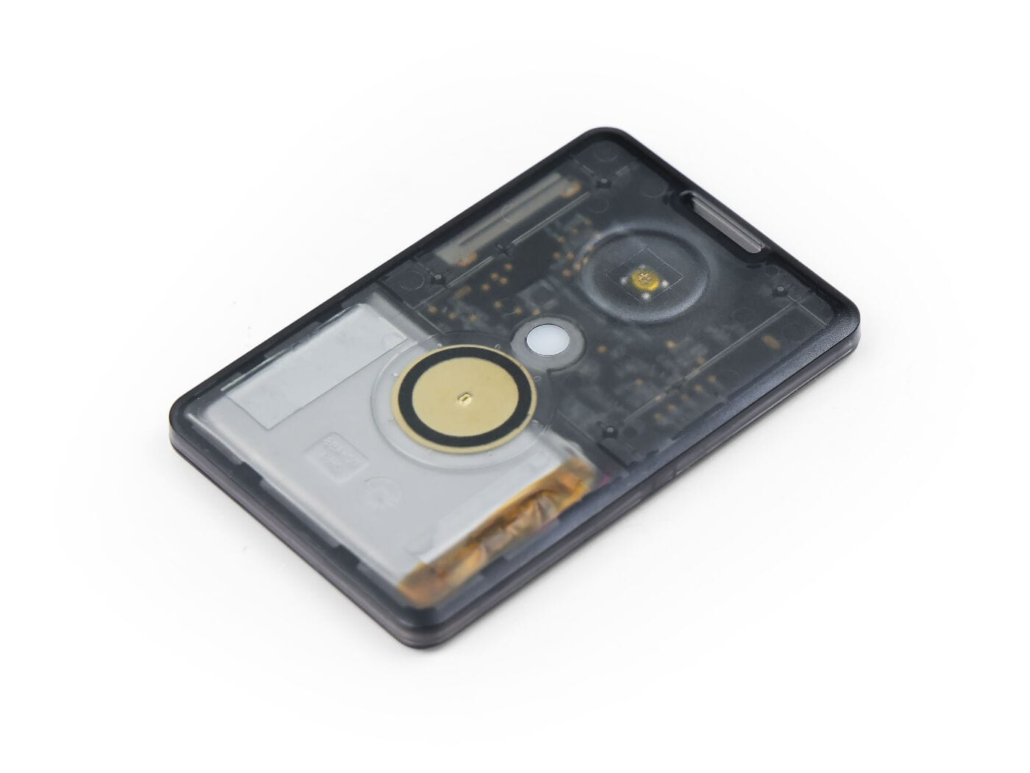
Features:
- Compact and Portable: The T1000-E is lightweight and easy to carry, whether it’s on a search mission or during daily emergency preparedness.
- GPS Integration: Integrated GPS tracking allows both rescuers and those needing assistance to be located accurately.
- IP65 Waterproof Rating: This makes it resistant to harsh weather conditions, including rain, dust, and snow, ensuring that it continues to operate reliably in the field.
Considerations:
- No Screen: Unable to display messages directly on the device; messages must be checked through connected devices or apps.
2. A device with an attractive enclosure that supports multiple RF technologies: T-Echo

Features:
- Low Power Consumption: With a power efficiency and reliability nRF52840 chip.
- Multi Wireless Connectivity: Support BLE5.0, Bluetooth Mesh, ANT, Zigbee,NFC.
- Backlit E-Ink Screen: Providing excellent outdoor readability in bright sunlight and ensuring that critical messages and information can be easily accessed in the field.
- GPS integration: Allowing for real-time tracking of both rescuers and people in distress.
Considerations:
- Limited Customization: If you’re looking for more flexibility or future expansion, other devices might offer more modularity.
- No Wi-Fi: It may limit your application in MQTT or other areas.
Suitable for Aviation Usage/SoftRF
If you are also an enthusiast of other projects like SoftRF, APRS, and so on, the following devices can support you in exploring diverse experiences.
For example, SoftRF is an open-source collision avoidance solution for aircraft. The following devices can receive and transmit aviation signals to help pilots understand surrounding traffic information and improve flight safety.
Recommended Devices:
- SenseCAP T1000-E
- T-Echo
- T-Beam
For more product details, you can check out the Google Doc or simply refer to the image below.
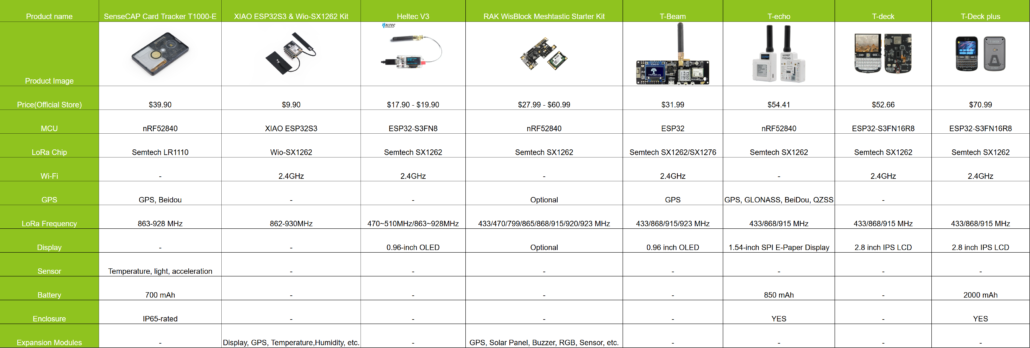
While many excellent Meshtastic-compatible products are available on the market, the ones listed above are perfect for beginners. They offer a friendly introduction to Meshtastic, and you can always explore more options on the official Meshtastic website here.
About Frequency
When choosing a Meshtastic-compatible product, make sure to select the one that supports the frequency band for your region. Below are some personal points for your reference:
- Local regulations and frequency restrictions: Different countries or regions allow different frequency bands. Common bands include 433MHz, 868MHz (Europe), and 915MHz (USA and some other regions). Check your local regulations before buying.
- Usage scenario: Lower frequencies (like 433MHz) offer better range and penetration but slower speeds. Higher frequencies (like 915MHz) provide faster data transfer but shorter range.
- Device compatibility: Ensure the device and module are compatible with the frequency band you need, as some devices only support specific frequencies.
Always check the product specifications and follow local laws to avoid using restricted frequencies.
About Antenna
Antennas play a vital role in Meshtastic devices, though I won’t go into too much detail here. In short, they can be categorized into three types: onboard, rod, and fiberglass. Onboard and rod antennas typically provide a communication range of 2-5 km, making them well-suited for portable nodes. Fiberglass antennas, by contrast, offer a longer range of 5-10 km, making them more appropriate for base stations or fixed nodes. The choice of antenna should be tailored to the specific device and use case.
Some Useful Resources
Here are some resources I believe will help you better understand Meshtastic that I want to share with you:
Article/Blog/Community Posts:
- Official Documentation: Everything about Meshtastic, including an intro, supported devices, software, etc.
- Reddit Explanation: A beginner-friendly explanation of Meshtastic by the community.
- Top Meshtastic Devices: A Comprehensive Guide by Adrelien: Reviews of popular Meshtastic devices like Seeed Studio SenseCAP Card Tracker T1000-E, RAK WisBlock Meshtastic Starter Kit, Heltec LoRa 32 V3, LILYGO T-Echo, LILYGO T-Beam.
- A Basic Guide to Meshtastic by Mike Oplinger: A fun and straightforward guide to LoRa, Meshtastic, and setup tips.
Videos:
- What Is Meshtastic by Ben Meadors: Lead developer of Meshtastic Ben Meadors explains Meshtastic.
- A Whole Getting Started Guide by The Comms Channel: A YouTube playlist covering getting started, device reviews, antenna testing, and more.
FAQs for New Meshtastic Users
1. Do I need technical knowledge to use Meshtastic?
No, anyone can use Meshtastic. A basic understanding of wireless communication, hardware devices, or open-source projects can help but is not required. New users can easily learn from the documentation provided.
2. Is Meshtastic free?
Yes, Meshtastic is a free and open-source project. You only need to buy Meshtastic-powered hardware devices. Software, firmware, and official documentation are all free. If you enjoy using Meshtastic, you can support the developers by making a donation.
3. Which operating systems are supported by Meshtastic apps?
Meshtastic provides official applications for Android and iOS etc. You can download the apps here.
4. What hardware devices are supported by Meshtastic?
Check the current list of supported devices on the official website. For the latest product releases, check popular vendors such as Seeed Studio, RAK, Heltec, and Lilygo.
5. Can Meshtastic send pictures or large files?
No, Meshtastic is not suitable for large data transmissions like images, videos, or files due to LoRa’s low bandwidth (a few hundred bytes per second). It is designed for short text messages and simple data transmission.
6. What is the communication range of Meshtastic?
The communication range depends on the environment and hardware configuration:
- Urban areas (with obstacles): 1-5 km
- Open areas (e.g., outdoors): Up to 10 km or more
By using the mesh network, the range can be extended by relaying messages through intermediate nodes.
7. Why can’t my devices communicate with each other?
Common reasons for communication issues include:
- Differing channel settings (channel name and encryption key must match).
- Devices are out of range (exceeded LoRa signal coverage).
- Hardware connection issues (e.g., antenna misinstallation).
- Firmware version incompatibility (ensure all devices use the same version).
8. How does the Meshtastic mesh network work?
Meshtastic uses a Mesh Network (LoRa-based), where every device(also called node) acts as both a transmitter and a repeater. Messages are automatically routed through multiple nodes until they reach their destination. Even if a node is out of direct communication range, other nodes in the mesh can relay messages and extend the coverage.
9. Where can I view official FAQs?
You can find the official FAQs here.
10. Where can I find help?
For support and community interaction, check the following:
Other recommended communities include:
- Discord:
- Facebook groups: